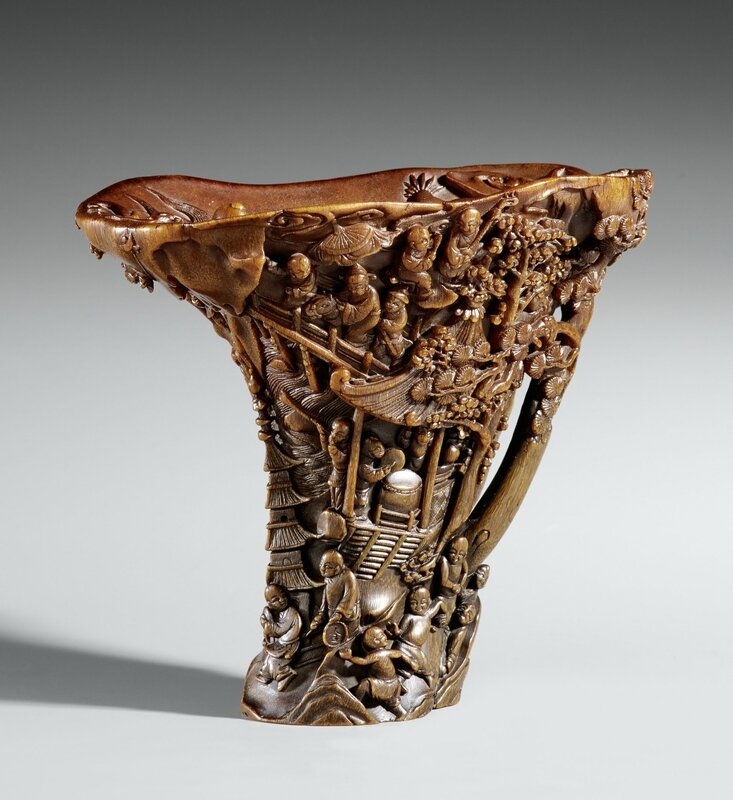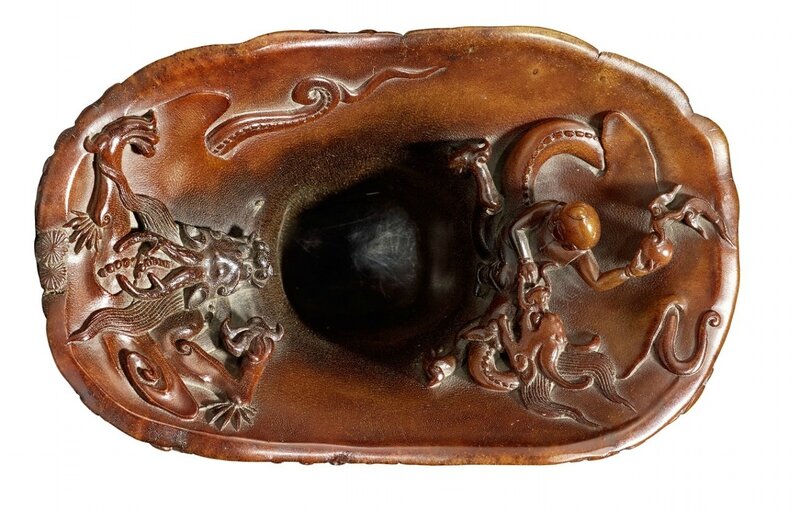A large rhinoceros horn libation cup, 17th-18th century
A large rhinoceros horn libation cup, 17th-18th century. Estimate €40.000 - €50.000. Photo courtesy Lempertz 1845
A large rhinoceros horn cup with a flaring rim, carved with a few undercuttings with the Hundred Boys at play and making music in a landscape with a pagoda, a music stage, a bridge underneath trees and pines, that form the handle, a large dragon and a boy with a flaming jewel on a rain dragon to the inside. Height 15.4 cm
Provenance Property of a European Gentleman
Literature Compare a similar libation cup, published in: Thomas Fok, Connaisseurship of Rhinoceros Horn Carving in China, Hong Kong 1999, no. 155
This lot contains materials which require a CITES licence for export outside of the EU contract countries. We would like to inform you that such licenses are usually not granted.
Notes: The „Hundred Boys" and "boys at play" rhinoceros cups are rather rare. One such cup with the mark Shang Ming formerly in the Fowler Museum Collection in California was bought by T. Fok, and was sold through Christie's, Hong Kong, 31.5.2010, lot 1815, together with the rest of his collection. Another unsigned cup was auctioned at Sotheby's, New York, 20.3.2012, lot 199.
The present lot compares well with these two cups. It displays a happy group of boys playing, the children depicted however are larger than in the examples referenced. The unusual decoration of a boy riding a dragon on the inside compares to the rhinoceros horn cup sold at Sotheby's. The motif is summed up in the saying wangzi chenglong (hoping the son becomes a dragon). The dragon itself represents success in the imperial examinations.
The subject of the "Hundred Boys" originated in the arts of the Song dynasty and became quite popular in the decorative arts of the Ming and Qing dynasties such as porcelain and textiles. The motif is said to represent the 99 sons of Zhou Wenwang, the founder of the Zhou Dynasty. When he came across Lei Zhenzi, he adopted him, making the number of sons he had an even one hundred. They represent the blessing of many male descendants to ensure the continuation of the family line. The subject of the "boys at play" also typifies the Chinese desire for many sons.
Lempertz 1845. Asian Art, 06.03.2015, 10:00, Cologne

/https%3A%2F%2Fprofilepics.canalblog.com%2Fprofilepics%2F1%2F0%2F100183.jpg)
/https%3A%2F%2Fstorage.canalblog.com%2F03%2F02%2F119589%2F96711876_o.jpg)
/https%3A%2F%2Fstorage.canalblog.com%2F11%2F31%2F119589%2F94773502_o.jpg)
/https%3A%2F%2Fstorage.canalblog.com%2F20%2F83%2F119589%2F94772815_o.jpg)
/https%3A%2F%2Fstorage.canalblog.com%2F26%2F72%2F119589%2F75604929_o.jpg)
/https%3A%2F%2Fstorage.canalblog.com%2F59%2F60%2F119589%2F26458628_o.jpg)




/image%2F1371349%2F20240229%2Fob_bcf2a6_429481554-1625272224909457-79208462982.jpg)
/http%3A%2F%2Fstorage.canalblog.com%2F51%2F60%2F119589%2F126452602_o.jpg)
/http%3A%2F%2Fstorage.canalblog.com%2F35%2F48%2F119589%2F126270429_o.jpg)
/http%3A%2F%2Fstorage.canalblog.com%2F27%2F14%2F119589%2F126269685_o.jpg)